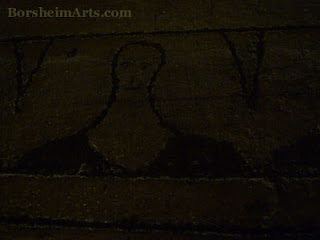Cari Amici (Dear Friends),
graf·fi·ti [gruh-fee-tee] :
Origin:
1850–55; < Italian, plural of graffito incised inscription or design, derivative with -ito -ite2 of graffiare to scratch, perhaps influenced by presumed Latin *graphīre to write; both probably derivative of Latin graphium stylus < Greek grapheîon; cf. graphic, grapho-, graft1
1850–55; < Italian, plural of graffito incised inscription or design, derivative with -ito -ite2 of graffiare to scratch, perhaps influenced by presumed Latin *graphīre to write; both probably derivative of Latin graphium stylus < Greek grapheîon; cf. graphic, grapho-, graft1
You may see here that the cement
was troweled onto the wall and then the designs were scratched into the
still-wet mixture. Just as in sculpting
in 3-dimensions, note that the artistan keeps the line at 90 degrees and crisp
when he wants a dark line [note the raised edges on the straight lines near the
top of the image], while he opens up the incision a bit if he was a lighter
effect [grey vs. black, curved lines in the bottom part of the image]. In something flatter than a proper bas
relief sculpture, these subtleties are about the only control the
artisan has to play with tone, other than using actual color later.
This third image shows how
this material ages… the wall becomes highly textured (and in my view, gorgeous)
in the process of erosion.
This next series illustrates
a couple of things. I have noticed here
in Italy (and maybe in other countries) that great art is one thing and
decoration quite another. However, it is
amazing what a simple design (technically speaking) can do for a space. Many times I have seen palaces and homes
decorated to the point of feeling almost too much on the wall patterns. But when you look at the design, it is simple
and repeated… not difficult per se, but it certainly gives a wondrous effect!
These last three images
confuse and amuse me a bit. I cannot
tell if the faces in the patterns are by the original artisan or if a different
person came along and added something closer to what we call “graffiti” today…
the faces. I am amused because you will
note that the simple shape drawn for each head and the very simple faces drawn
still result in what seems to me to be unique personalities.
A man…
A woman…
A work of art by Edvard
Munch (author of “The Scream”). What do
you see?
I hope that you enjoy my
little examinations of traditional Italian graffiti: More
in the next post.
Past posts about Italian
graffiti:
The sign of the Medici
family (6 balls on the shield): http://artbyborsheim.blogspot.it/2012/10/graffiti-florence-italy.html
Few things last forever,
disappearing graffiti: http://artbyborsheim.blogspot.it/2012/10/more-graffiti-florence-italy.html
Today’s form of graffiti: http://artbyborsheim.blogspot.it/2007/09/italian-graffiti.html








No comments:
Post a Comment